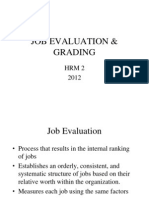Behavior Based Interviews-Star
Behavior Based Interviews-Star
Uploaded by
Monica ReyesCopyright:
Available Formats
Behavior Based Interviews-Star
Behavior Based Interviews-Star
Uploaded by
Monica ReyesCopyright
Available Formats
Share this document
Did you find this document useful?
Is this content inappropriate?
Copyright:
Available Formats
Behavior Based Interviews-Star
Behavior Based Interviews-Star
Uploaded by
Monica ReyesCopyright:
Available Formats
STAR - Behavioral Interviewing Overview for Managers
The selection of a new team member is a major investment for our organization and the candidate. Developing and maintaining a selection system that yields solid returns productive employees who enjoy their responsibilities and seek opportunities to continuously improve their jobs is critical to the success of every organization. The most effective selection systems share three goals: Accuracy Equity Buy-In
Accuracy is the ability of the selection process to validly predict applicants job performance. Equity is the assurance that the selection system gives every qualified applicant a fair and equal chance to be selected. Buy-In is the extent to which the people involved in the selection process perceive its worth, both interviewers and candidates. Many companies have adopted such a system of interviewing, utilizing the behavioral method, and have trained and certified their leaders to conduct these interviews.
STAR - Behavioral Interviewing Components
The accuracy and fairness of the behavioral interviewing system are based on six components. By following these components, the leader will be able to: Focus interviews and selection procedures on job-related information. Organize the elements of the selection process into an efficient system. Obtain specific behavioral information that can be used accurately to predict future behavior. Assess the motivational fit of candidates. Systematically share information about candidates in an organized data integration session. Make legally credible hiring decisions.
STAR - Behavioral Interview Focus
The interviewer will be focusing on competencies that serve as keys for collecting data. Competencies -- describe the knowledge, motivations, and behaviors associated with success or failure in a job.
A competency -based interviewing format focuses on the particular knowledge, motivations, and behaviors important in the specific job or role and eliminates unrelated questions that waste time or are illegal. Interviewers rely on three general type of information when gathering data about candidates: Work/Education History/Certification/Skills The candidates broad, general background. This information, much of which can be found on an application form or a resume, includes: o Where a candidate went to school o Number of years of service with a company o Number of job changes o Licenses and certifications o Ability to use specific computer software o Familiarity with industry procedures o Ability to operate specialized equipment
Specific Experiences Specific things the candidate has done in his or her jobs or other relevant history. For example: o The time the candidate sold an idea to his or her group leader. o A major project for which the candidate developed the budget. o The time the candidate resolved a conflict with a team member Interests/Desires What the candidate is looking for in a job, organization, and location. Interviewers should note this information and confirm it with examples during the interview.
STAR - Behavioral Examples
Hiring managers who are certified in behavioral interviewing will use behavioral examples to clarify information. Recognizing the relationship between the three sources of information and target dimensions are a key skill for the interviewer. While it might be easy to gain a superficial understanding of this relationship, failure to clarify information details that dont appear on a resume/application or arent discussed in the interview can mislead interviewers. Behavioral
Interviewing overcomes this problem by helping interviewers focus on collecting behavioral examples. Specific information about the situation and what the person actually did helps to accurately predict how the candidate will behave in similar situations in the future. Past behavior predicts future behavior. This is called the STAR method. The ST situation the candidate faced The Action the candidate took (What did the person do) The Result of the candidates actions.
You might also like
- Never - Ending - Quest - Graves PDFDocument592 pagesNever - Ending - Quest - Graves PDFGiovanna Arzamendia Trinidad100% (9)
- Amazon Interview QuestionsDocument15 pagesAmazon Interview Questionsraldaz100% (6)
- Amazon'sW Wriitng SampleDocument2 pagesAmazon'sW Wriitng SampleShanaRubin25% (4)
- Amazon Interview CourseDocument361 pagesAmazon Interview CourseShreya Sachan100% (11)
- Amazon Interview MethodDocument9 pagesAmazon Interview MethodHM75% (8)
- Think BigDocument2 pagesThink BigJane Anthony67% (3)
- Behavioral Health ProfessionalsDocument5 pagesBehavioral Health ProfessionalsNoelle RobinsonNo ratings yet
- Amazon InterviewDocument14 pagesAmazon Interviewyashwanthr333% (6)
- Amazon Interview HelpDocument3 pagesAmazon Interview HelpPalashNo ratings yet
- Smart-Shaming The Living Experiences of Smart Shamed Students in AcademeDocument59 pagesSmart-Shaming The Living Experiences of Smart Shamed Students in AcademeKyla Calipayan91% (11)
- Amazon Interview QuesDocument7 pagesAmazon Interview QuesNeha Sharma100% (2)
- Final Exam Research - HijadaDocument4 pagesFinal Exam Research - HijadaJeanette50% (2)
- Candidate PreparationDocument1 pageCandidate PreparationamitNo ratings yet
- Amazon Consolidated Interview Experience DocumentDocument4 pagesAmazon Consolidated Interview Experience DocumentNiraj Kumar100% (1)
- How To Answer Interview Questions About Amazon Leadership Principle"earn Trust" - Interview GenieDocument9 pagesHow To Answer Interview Questions About Amazon Leadership Principle"earn Trust" - Interview GenieAadrita Ghosh100% (1)
- The 14 Amazon Leadership Principles: Common Questions For Each PrincipleDocument19 pagesThe 14 Amazon Leadership Principles: Common Questions For Each PrinciplerohanNo ratings yet
- Industry Analysis: Real Estate IndustryDocument65 pagesIndustry Analysis: Real Estate IndustryMonica Reyes93% (15)
- 25 Amazon Operations Manager Interview Questions & Answers: Order ID: 0081249Document13 pages25 Amazon Operations Manager Interview Questions & Answers: Order ID: 0081249vinayakrsutarNo ratings yet
- Amazon 14 LeadershipDocument6 pagesAmazon 14 LeadershipSheetanshu AgarwalNo ratings yet
- Amazon InterviewDocument3 pagesAmazon InterviewMihai Marin0% (1)
- 2020 NDE FAQ & Spec DublinDocument4 pages2020 NDE FAQ & Spec DublinVarga A Paul0% (1)
- Behavioral Interview Questions A Complete Guide - 2021 EditionFrom EverandBehavioral Interview Questions A Complete Guide - 2021 EditionNo ratings yet
- Focus Child Summary SpencerDocument3 pagesFocus Child Summary Spencerapi-360799511100% (1)
- Cultivating CreativityDocument63 pagesCultivating CreativityPhilip Finlay Bryan95% (19)
- The Best 299 Interview Questions for Top Recruiters: Right Questions •Right Interpretations •Right Matching •Right EmployeesFrom EverandThe Best 299 Interview Questions for Top Recruiters: Right Questions •Right Interpretations •Right Matching •Right EmployeesNo ratings yet
- GeeksforGeeks Placement QuestionsDocument35 pagesGeeksforGeeks Placement QuestionsRadhika ParikNo ratings yet
- Interview EssayDocument17 pagesInterview EssaySanjeev AggarwalNo ratings yet
- Amazon 3 - How To Interview at Amazon Using The Amazon Leadership PrinciplesDocument7 pagesAmazon 3 - How To Interview at Amazon Using The Amazon Leadership PrinciplesmridulbhardwajNo ratings yet
- Interview Advice: How To Answer Interview Questions About The Amazon Leadership Principle "Think Big"Document8 pagesInterview Advice: How To Answer Interview Questions About The Amazon Leadership Principle "Think Big"Sanjeev Aggarwal100% (1)
- Template - Interview Stories For Amazon Leadership InterviewsDocument7 pagesTemplate - Interview Stories For Amazon Leadership InterviewsYumi TanzoNo ratings yet
- Leadership Principle Interview Questions by PrincipleDocument23 pagesLeadership Principle Interview Questions by PrincipleSoumak BanerjeeNo ratings yet
- Interview Questions and AnswersDocument51 pagesInterview Questions and AnswersAnup Mahakud83% (6)
- WritingSample 1 PDFDocument2 pagesWritingSample 1 PDFAkinbolajo OlumideNo ratings yet
- How To Ace Your Amazon InterviewDocument15 pagesHow To Ace Your Amazon InterviewDeepti Kaushal71% (7)
- Amazon InterviewDocument2 pagesAmazon Interviewnirmaan70% (1)
- Amazon Phone Interview Prep. 1Document3 pagesAmazon Phone Interview Prep. 1Georges Henry100% (1)
- How To Answer Amazon "Deliver Results" Interview Questions: Jennifer ScupiDocument4 pagesHow To Answer Amazon "Deliver Results" Interview Questions: Jennifer Scupichetan choudhari100% (2)
- 29 Interview Questions Amazon Uses To Find The Best Employees - Inc PDFDocument2 pages29 Interview Questions Amazon Uses To Find The Best Employees - Inc PDFrcbhavsar4402No ratings yet
- Interview PreparationDocument4 pagesInterview PreparationMAdhu mNo ratings yet
- Leadership Interview Questions (With Answers) - ZippiaDocument16 pagesLeadership Interview Questions (With Answers) - ZippiaSAGAR SHARMANo ratings yet
- Amazon Leadership PrinciplesDocument5 pagesAmazon Leadership PrinciplesAbhishek YadavNo ratings yet
- Amazon Interview Experiences 2016-2017 PDFDocument10 pagesAmazon Interview Experiences 2016-2017 PDFDaood100% (1)
- Amazon Interview Prep Notes PDFDocument2 pagesAmazon Interview Prep Notes PDFDeepak100% (1)
- IT-Technical RecruiterDocument3 pagesIT-Technical RecruiterchugulaNo ratings yet
- Amazon PrinciplesDocument16 pagesAmazon Principlesreddygantasri31100% (1)
- STAR MethodDocument2 pagesSTAR MethodJohn David100% (1)
- Tell Me About Yourself?Document6 pagesTell Me About Yourself?Carlos Luna CaratiNo ratings yet
- Build Great Answers:: Sample Responses To Common Interview QuestionsDocument29 pagesBuild Great Answers:: Sample Responses To Common Interview QuestionskdasNo ratings yet
- QA Lead Interview QuestionsDocument11 pagesQA Lead Interview Questionsemail2raiNo ratings yet
- 5+TIPS+FOR+PASSING+THE+AMAZON+INTERVIEW TrackedDocument4 pages5+TIPS+FOR+PASSING+THE+AMAZON+INTERVIEW TrackedHabib ImamNo ratings yet
- Senior TPM - AmazonDocument2 pagesSenior TPM - AmazonRohit SahniNo ratings yet
- (Drnancyli - Com) The Top10 Clarifying Questions To Ask A Product Management InterviewerDocument4 pages(Drnancyli - Com) The Top10 Clarifying Questions To Ask A Product Management InterviewerDharma SetiawanNo ratings yet
- AMAZON+AWS+Interview+Questions+and+Answers TrackedDocument11 pagesAMAZON+AWS+Interview+Questions+and+Answers TrackedErnestNo ratings yet
- Amazon Interview QuestionsDocument107 pagesAmazon Interview QuestionsRonak PanchalNo ratings yet
- Recruiter's Interview Q & A 22Document4 pagesRecruiter's Interview Q & A 22Secretariat ClerkNo ratings yet
- How To Answer Amazon "Frugality" Interview Questions: Jennifer ScupiDocument3 pagesHow To Answer Amazon "Frugality" Interview Questions: Jennifer Scupichetan choudhariNo ratings yet
- Amazon Leadership Principles ExamplesDocument11 pagesAmazon Leadership Principles ExamplesiremNo ratings yet
- Have Backbone Disagree and CommitDocument5 pagesHave Backbone Disagree and Commitchetan choudhariNo ratings yet
- Interview QuestionsDocument5 pagesInterview QuestionsRonnel Aldin FernandoNo ratings yet
- Amazon PrinciplesDocument9 pagesAmazon PrinciplesDiptarghya Kundu100% (1)
- Phone Interview Questions For QA TestersDocument3 pagesPhone Interview Questions For QA TestersGuru VelmathiNo ratings yet
- Invent and SimplifyDocument2 pagesInvent and SimplifyNishant SharmaNo ratings yet
- Manager's Behavioral Interview QuestionsDocument18 pagesManager's Behavioral Interview QuestionsAl Ismael100% (2)
- 2019 Behavioral Interview Questions and AnswersDocument6 pages2019 Behavioral Interview Questions and Answerspabusof100% (3)
- Amazon Interview Tips and HintsDocument2 pagesAmazon Interview Tips and HintsArboreallyNo ratings yet
- TablesDocument4 pagesTablesMonica ReyesNo ratings yet
- JOb Evaluation and Job Grade3Document3 pagesJOb Evaluation and Job Grade3Tamer Maher100% (1)
- Job Evaluation & Grading - PPT Hrm2Document9 pagesJob Evaluation & Grading - PPT Hrm2Monica Reyes100% (1)
- Epic Moo Time ReportDocument19 pagesEpic Moo Time ReportMonica ReyesNo ratings yet
- Designing Your Organization - PPT HRM 2Document3 pagesDesigning Your Organization - PPT HRM 2Monica ReyesNo ratings yet
- EM-BusPlanpres - HR Presntatn. Midterm.8.15Document2 pagesEM-BusPlanpres - HR Presntatn. Midterm.8.15Monica ReyesNo ratings yet
- Pre-NBV: Business Idea: Linea Arielle C. Dumag Mentor: Ms. Maria Olivia OllorenDocument15 pagesPre-NBV: Business Idea: Linea Arielle C. Dumag Mentor: Ms. Maria Olivia OllorenMonica ReyesNo ratings yet
- NBV O: By: Demer SunDocument14 pagesNBV O: By: Demer SunMonica ReyesNo ratings yet
- Business Model: Reporter: Monica O. ReyesDocument46 pagesBusiness Model: Reporter: Monica O. ReyesMonica ReyesNo ratings yet
- QUICHODocument18 pagesQUICHOMonica ReyesNo ratings yet
- Pulse: Medical Convenience VanDocument32 pagesPulse: Medical Convenience VanMonica ReyesNo ratings yet
- PEREZDocument35 pagesPEREZMonica ReyesNo ratings yet
- My Business Idea: Presentation By: Mac PuaDocument8 pagesMy Business Idea: Presentation By: Mac PuaMonica ReyesNo ratings yet
- Nbv0 by Yong Jun Kim March 12, 2011Document11 pagesNbv0 by Yong Jun Kim March 12, 2011Monica ReyesNo ratings yet
- NBV 0 My Business Idea: JunkshopDocument20 pagesNBV 0 My Business Idea: JunkshopMonica ReyesNo ratings yet
- CH 14Document52 pagesCH 14Monica ReyesNo ratings yet
- GIMENEZDocument9 pagesGIMENEZMonica ReyesNo ratings yet
- EFQMDocument4 pagesEFQMMonica ReyesNo ratings yet
- Winrer 2016 Course Outline Pregrad Nurs 253 1Document20 pagesWinrer 2016 Course Outline Pregrad Nurs 253 1api-315331895No ratings yet
- A Practical Guide To Working With The 16 Personality TypesDocument6 pagesA Practical Guide To Working With The 16 Personality TypesJudy Galofre-LewisNo ratings yet
- 14 Yoursmartclass-Com-Action-Research-On-The-Lack-Of-Interest-In-The-Classroom-AmpDocument19 pages14 Yoursmartclass-Com-Action-Research-On-The-Lack-Of-Interest-In-The-Classroom-Ampcemepe10400% (1)
- Non Verbal CommunicationDocument3 pagesNon Verbal Communicationchandy RendajeNo ratings yet
- Session 8&9 - Truth vs. False Claim Activity - FinalDocument3 pagesSession 8&9 - Truth vs. False Claim Activity - FinalJean Patrice SolimanNo ratings yet
- Organizing and Delivering A Memorized SpeechDocument12 pagesOrganizing and Delivering A Memorized SpeechSHIELA MAY PIANO100% (2)
- Baer2008 FFMQDocument15 pagesBaer2008 FFMQSOFIA YUMIKO BAUTISTA GUERRERONo ratings yet
- Classroom Assessment Handouts Edu 405Document89 pagesClassroom Assessment Handouts Edu 405Gohar YaseenNo ratings yet
- Reviewer in Al1Document5 pagesReviewer in Al1Dannah Fe FranciscoNo ratings yet
- A Passage To AfricaDocument17 pagesA Passage To AfricaKristin JullinenNo ratings yet
- Rewards and RecognitionDocument20 pagesRewards and RecognitionJeena James ReddyNo ratings yet
- Love Systems Insider: Social Circle Mastery, Part 2Document6 pagesLove Systems Insider: Social Circle Mastery, Part 2Love Systems0% (1)
- Epp 5Document3 pagesEpp 5Jamaica MamauagNo ratings yet
- Validation Tool SummaryDocument7 pagesValidation Tool SummaryP MarieNo ratings yet
- Human Behavior in OrganizationDocument25 pagesHuman Behavior in OrganizationPeter GonzagaNo ratings yet
- The CBE Story A Strategic Storytelling ToolkitDocument28 pagesThe CBE Story A Strategic Storytelling ToolkitAndreaMartinezRojasNo ratings yet
- Quality Self-Reflection Through Reflection TrainingDocument13 pagesQuality Self-Reflection Through Reflection TrainingPrincess Devi Spada Joe IINo ratings yet
- Final ResearchDocument21 pagesFinal ResearchJustine TabatNo ratings yet
- Reflection On English Language Proficiency SubjectDocument2 pagesReflection On English Language Proficiency Subjectnurulaidahamdan71% (7)
- The Extended Fishbein ModelDocument1 pageThe Extended Fishbein ModelI Nyoman Sujana GiriNo ratings yet
- Module Information Booklet Taylor's UniversityDocument25 pagesModule Information Booklet Taylor's UniversityeduNo ratings yet
- PR2 Research TemplateDocument37 pagesPR2 Research TemplateAngelica VelascoNo ratings yet
- Review of Richard R. Valencia & Lisa A. Suzuki's ''Intelligence Testing and Minority Students - Foundations, Performance Factors, and Assessment Issues'' (2002) by Arthur Robert JensenDocument2 pagesReview of Richard R. Valencia & Lisa A. Suzuki's ''Intelligence Testing and Minority Students - Foundations, Performance Factors, and Assessment Issues'' (2002) by Arthur Robert JensenΞανθόπουλος ΠαύλοςNo ratings yet
- Personal Relationships T.G.Document5 pagesPersonal Relationships T.G.Marichu Cayabyab0% (1)












































































































